The Subsurface Digital Journey
Cegal maneuvers E&P clients steadily through what we call their digital journey. Our focus is on helping clients succeed with their business goals. Clients can be at different maturity levels in their journey, so there are several methods and technologies that we can apply to help them succeed.
In this article, I will discuss some of the challenges we see with our clients and give a few examples of making digital maturity gains, using a mix of newly developed features and off- the-shelf products from partners.
For your convenience, here are the highlights of its content:
- Phases in the digital transformation
- Digital maturity assessment
- Business value-driven digitalization
- Ensuring innovation success
- Digitalization workflow methodology
- Bringing projects faster into production
- Cloud-native seismic platform POC
- Evergreen Maps
- Embarking on the subsurface digital journey
Are you ready? Let's go.
Enabling the digital transformation journey
Cegal’s digitalization mission is to transform business processes aligned with our clients' current digital adoption and ongoing business life cycle activities. Our foundation is a cloud-based and vendor-agnostic workspace that makes applications and data available anywhere and on any platform.
We’ve identified a few critical issues when supporting E&P companies to succeed in becoming data-driven and digitally-enabled:
- A never-ending focus on business value and why you are doing what you do
- Deliver quick value via incremental agile change
- If possible, digitalize pragmatically
Phases in the digital transformation
The figure describes some typical phases an E&P company goes through in their digital transformation journey.
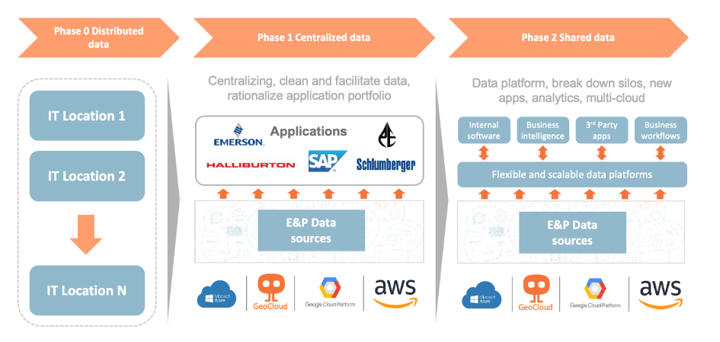
Phase 0: Companies experience poor collaboration and severe security challenges from a distributed IT setup. Data is distributed and often difficult to find. Besides, data can be duplicated, and it’s hard to know what data to trust.
Phase 1: Utilizing Cetegra, we centralize data and develop a uniform user experience across the user base. With increased security and a lot better means of collaboration, cross-site distributed teams can thrive.
In this scenario, we can clean up and rationalize the application portfolio. However, data is often closely tied to the applications – and this might hamper new workflow innovations.
Phase 2: Once the data and applications are centralized, you can start optimizing your workflows and investing in new working ways. Separating the data from the application-controlled silos is essential to achieve a democratized access. Investing in open data platforms and new applications is now possible, and a future roadmap can be set up.
Digital maturity assessment
Assessing how digitally mature your company is can be a complicated task. But answering a few essential questions should help you indicate a certain level upon which you may develop a digital strategy, establish business pain points, and carve out a road map for your digitalization process. Agile prioritization and execution should follow once you’ve mapped the initial pain points.
Finding answers to these questions is a good start:
Data
- Where's your data today?
- How does your business consume data?
- Any possibility of cross-site collaboration on your data?
- Show me your application list – is data tightly locked to the application, are there overlapping workflows?
Operational
- Do you have security concerns with your data?
- Are different standards used across the company?
- IT is traditionally built for control and stability – how do you enable innovation?
Planning and cultural aspects
- Do you have a digital change program?
- How do you prioritize your digital projects?
- How do you measure digital success?
In our opinion, these mostly data-related questions indicate the highest potential for short term gains. Data platforms and other new ways of working will come later, but now it’s all about moving data away from application silos and providing pragmatic, value-driven digitalization.
Business value-driven digitalization
To ensure (focus on) the business value of a digitalization project, we often apply the following approach in whole or parts.
First, we instantly evaluate the idea or project using an enhanced business model canvas. It allows us to ask important questions about the concept quickly:
- Why, what, and how
- Value proposition
- Early adopters
- Revenue/cost
- Problems to solve
Then we compare it to other ideas we have in the innovation portfolio. Using the same methodology across all your digital projects, you have a higher chance of selecting the right project for your organization. Imagine a funnel where just some ideas make it through to the end.
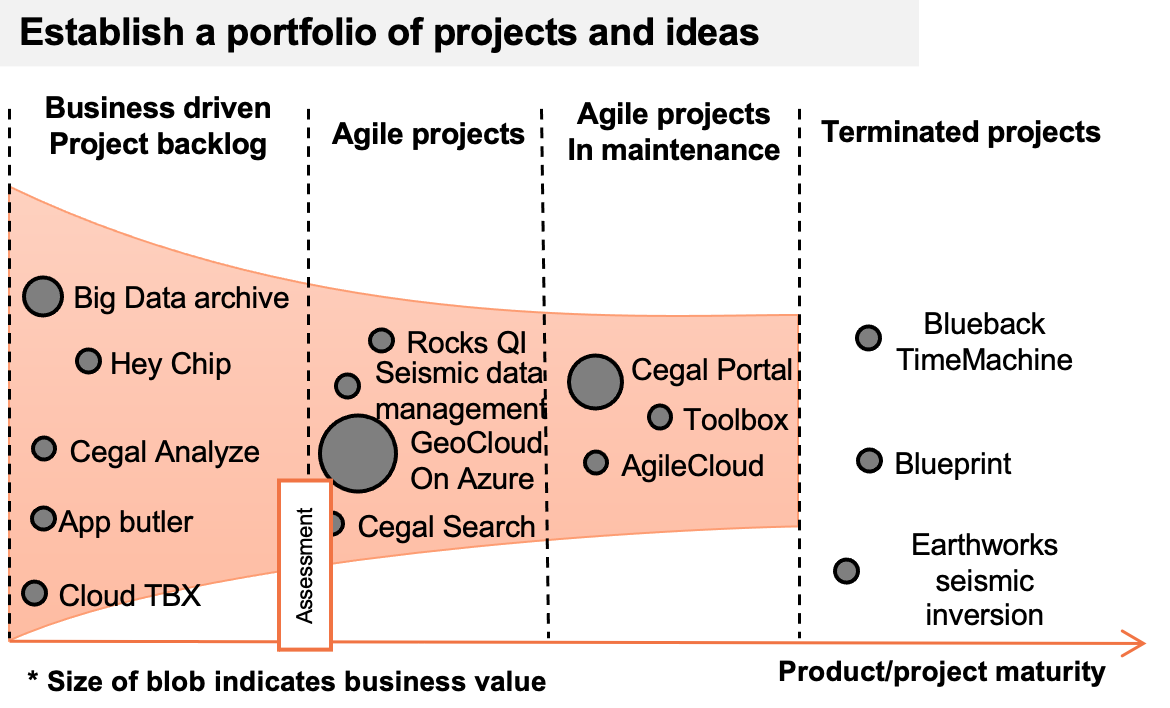
Once an idea is selected, we run it as an agile project in a Cetegra Innovation space, focusing on:
- Rapid development of MVP’s in short project iterations
- Focus on
- Failing fast – this leads to reduced risk and accelerated learning
- Pivot if not quite right
- Strong stakeholder involvement
- Relentless focus on business value-based prioritization
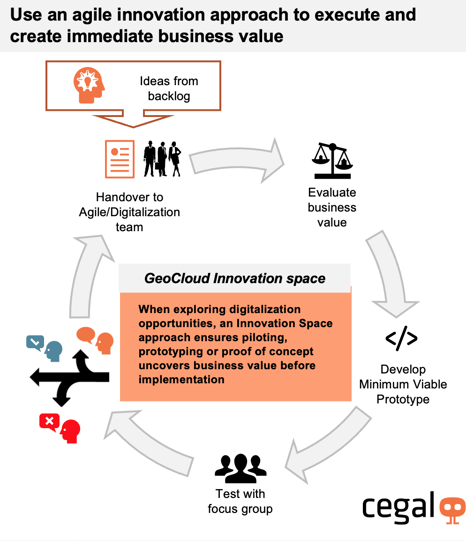
We recommend starting with why you want to solve the problem before determining how to solve it. What technology to use is more about the execution and should not be in focus initially. However, having a rich digitalization toolkit that you master at your fingertips surely helps once you have defined the problem to solve.
Ensuring innovation success
Traditionally, IT in larger corporations focuses on control and stability. Innovation teams, on the other hand, are agility and speed-driven. So how can we help clients speed up their innovation – without compromising on security and governance?
In the Cetegra innovation space, innovation projects can test new solutions, create new products, and construct the direct deployment pipelines to the operational IT environment. It is also excellent for testing out integrations to new platforms and changing how data management works with data. Moreover, you have the option of experimenting with microservices and new ways of working, such as data science for your subsurface teams.
The solution will give the organization a better vehicle to conduct innovation projects and is deployed next to Cetegra.
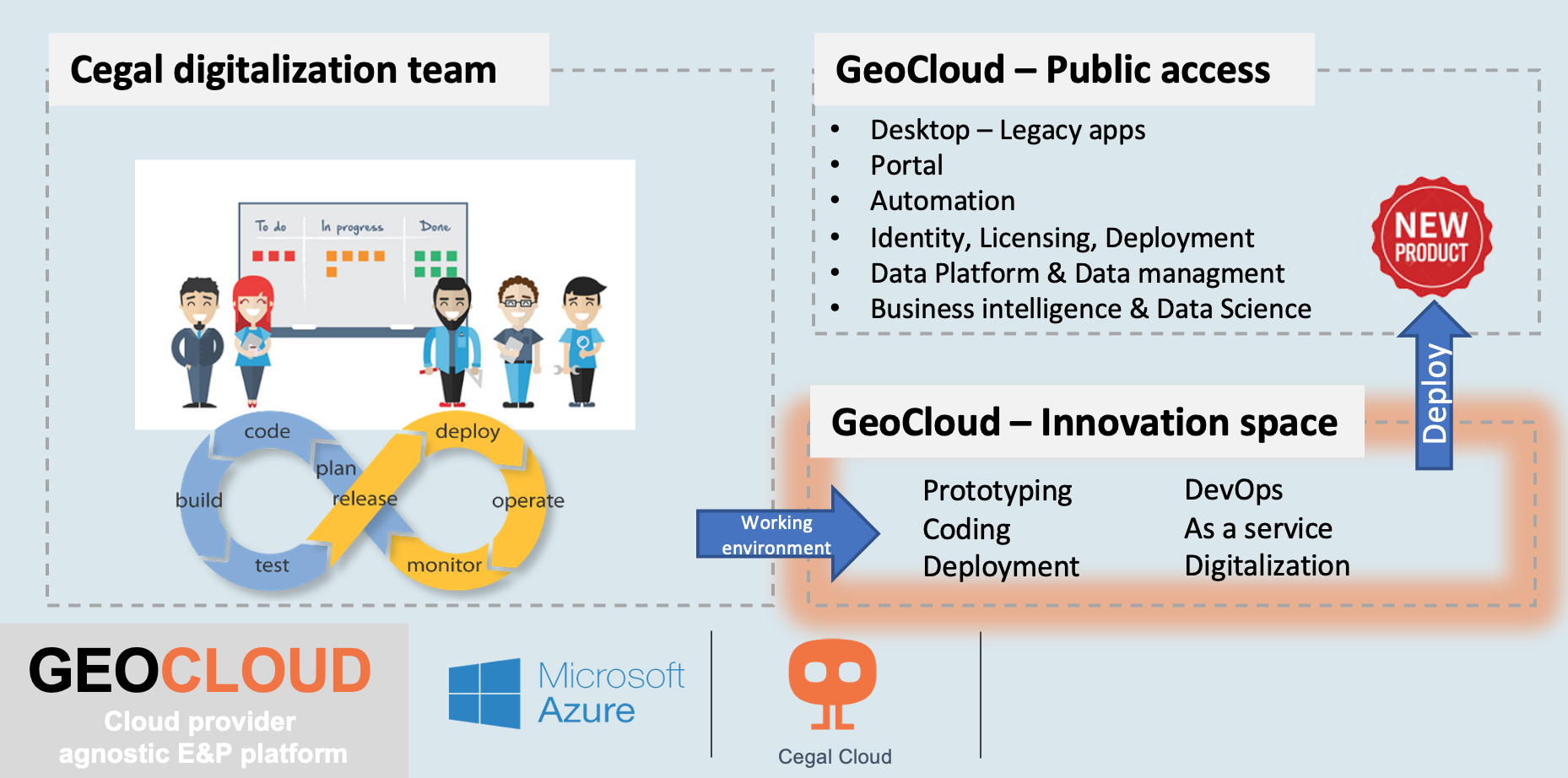
Digitalization workflow methodology
At Cegal, we assist our oil and gas clients on many levels. Using the toolkits mentioned, we can help businesses digitalize in many ways. Through simple means, you can do quite a lot without embarking on a large digitalization project. In the example below, a new subsurface workflow is designed. A novel algorithm for detecting faults was published. It was believed that this method could help clients with quicker fault mapping.
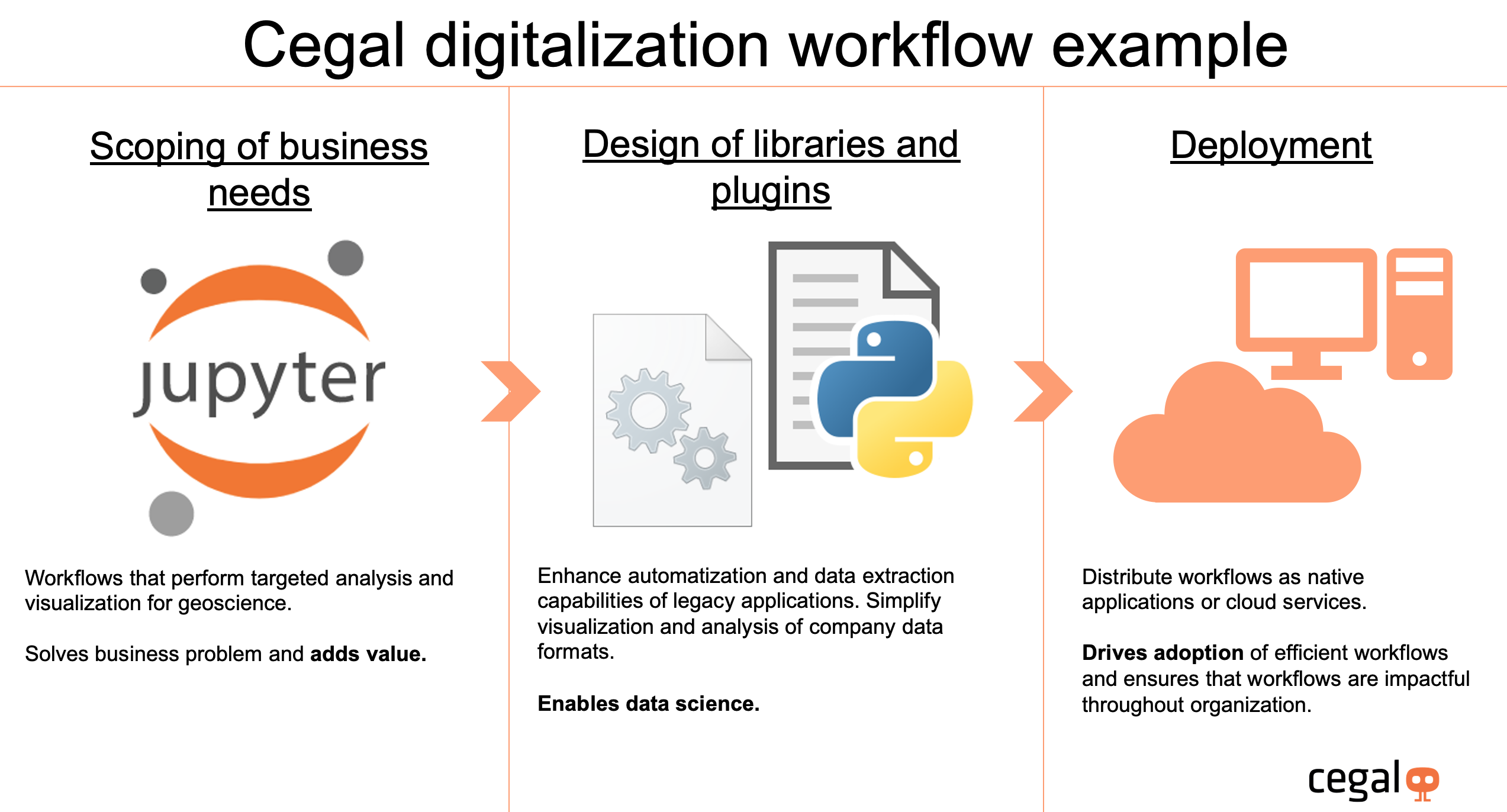
We usually start with an in-depth look at the problem and engage with the business users to set a scope and build a backlog.
The next step would be designing a solution using some of the tools we have at hand.
Deploying these solutions is essential, and by automating them, you enable continuous improvement of the tool. As an end-user, you would traditionally have to wait for a new software version to access new functionality, but now there are alternative ways to quickly access technological advancements! An advanced user may consume the data science Jupyter Notebook’s output and share it directly with end-users, as described in the second stage. But there are times when you need more straightforward ways of deploying this to end-users, and the next example shows an alternative approach.
In this case, we had found some interesting research code on github. It had created much interest from the industry, so we decided to assess the code to see if it was possible to create a workflow we could efficiently distribute to end-users.
After prototyping in our Blueback Python Tool, we started to extract data from Petrel and create the more comprehensive workflows in a Jupyter Workbook. But as I mentioned, Jupyter Notebook may not be everyone’s cup of tea, so we decided to compile a Python script in real-time, looking like an application. The program runs when you press the ‘calculate’ button with PETREL open, thus providing a simple user interface.
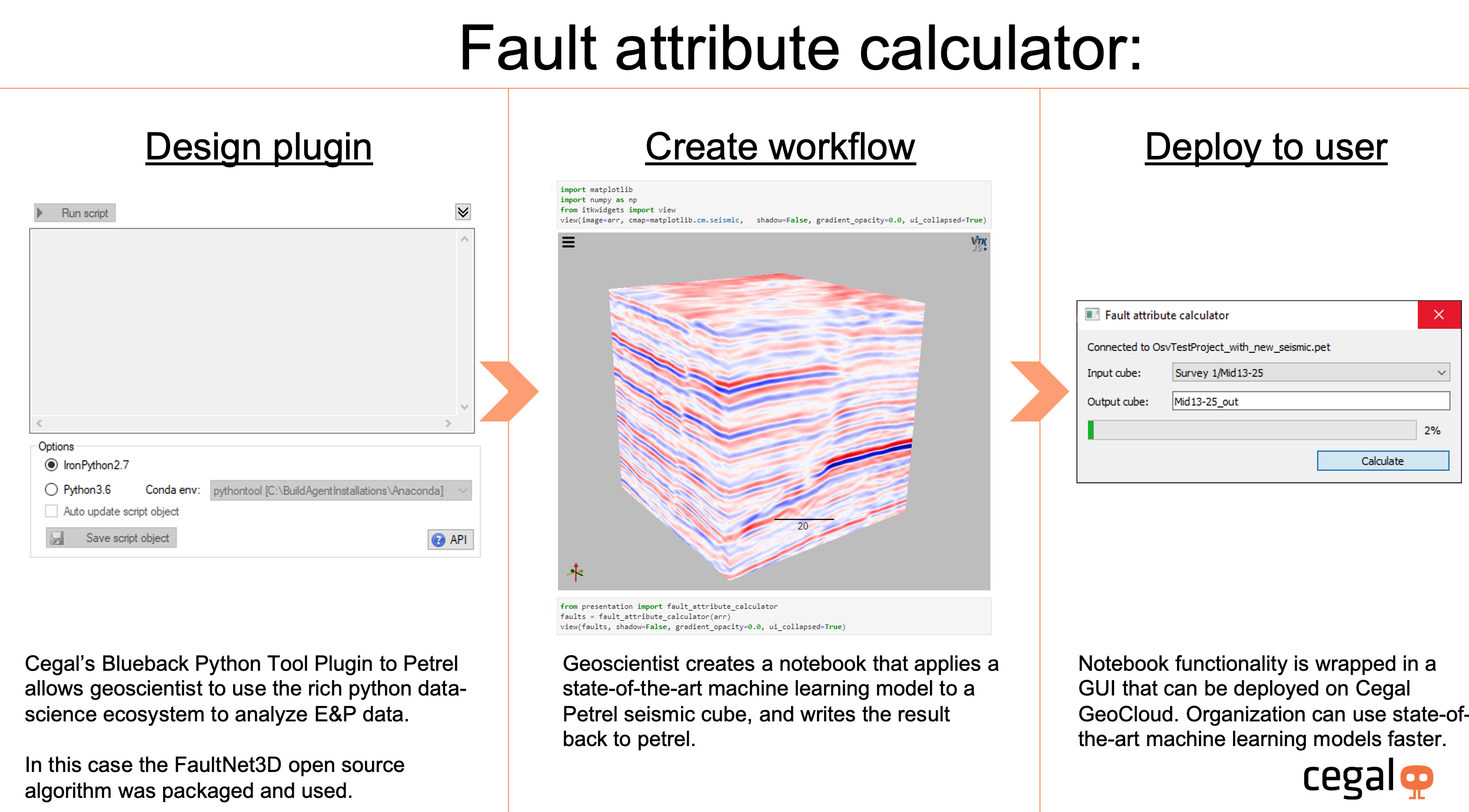
https://github.com/xinwucwp/faultSeg
Using this methodology, you can provide solutions to the end-user in a matter of weeks or months rather than a perspective of many years. Thus, the business value of such a project appears quickly.
Bringing projects faster into production
The next example is from an ongoing project with Neptune Energy. Cegal is a trusted partner for Neptune, providing Cetegra for its subsurface staff, and we’re also contributing with data scientists and software developers to the Digital Subsurface Innovation Team. As part of its growth and accelerated value creation plans, they established a program aiming to bring projects faster into production.
- Structure:
- Next-generation workflows
- Data platform
- Infrastructure for the future
- Key challenges:
- With an aging infrastructure, Neptune needs to upgrade and add new functionality to increase efficiency
- Their data is scattered, static and has many different formats; the access to relevant data must improve
- Data-driven methods must replace traditional application-controlled ones to utilize large amounts of unused data
- The journey must be de-risked and understood while the shape and functionality of a future data platform is still uncertain
- Besides, when data is available from a new data platform, new applications and workflows can be designed
- Important business benefits:
- Centralizing data and the system maintenance with Cetegra in all locations will improve collaboration
- Adopting agile and fail fast principle in projects will speed up tech delivery to the organization
- Testing and benchmarking available products and optimizing with new solutions is a pragmatic approach to digitalization
- The program will help Neptune innovate faster in the geophysical space by being early movers of geophysical (seismic) workflows to OSDU®
Cloud-native seismic platform POC
My next example is from a joint POC with Neptune Energy, Microsoft, Cegal, and Bluware. The ambition was to construct a cloud-native seismic platform where data is stored in one location and served to current and new applications. We would utilize Bluware’s OSDU®-compliant seismic format VDS together with their FAST system configured in Cegal’s Cetegra on Azure.
In this OSDU® journey de-risking exercise, we demonstrated that data stored in Cetegra in one location could be utilized with excellent performance. The additional advantage of the Bluware solution is that you can compress the data, both streaming in real-time and permanently. Consequently, the move to a public cloud is more feasible, saving on bandwidth and storage while maintaining data quality.
Cegal contributed with technology, domain insight, and project management to realize this project and continue to work with Neptune in the further digitalization work of the subsurface workflows.
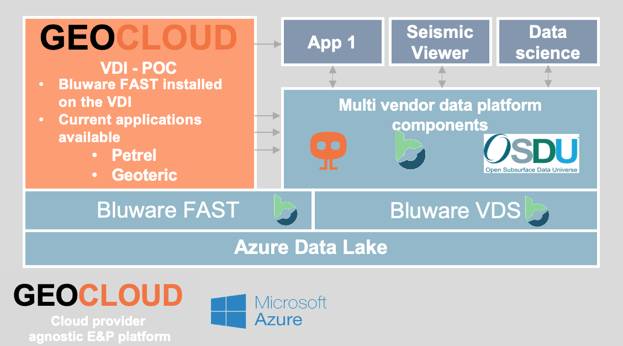
Evergreen Maps
The last example demonstrates how we support Neptune Energy in facilitating digitalization and moving to the new data platforms. As part of the program, we are also helping them in solving current problems. In the program, we have developed a new workflow called Evergreen Maps.
- Key Challenges:
- Find the best seismic interpretation for key stratigraphic formations from thousands of PETREL* projects. •
- How to keep regional maps up-to-date with the best available interpretations whenever new seismic is available?
- Solution:
- Building on top of Blueback Project Tracker, we could extract relevant metadata, data for interpretation, surveys, and seismic and group the data by stratigraphy and survey.
- A Python-based tool was created, using machine learning to classify horizon interpretations into good and bad.
- Other tools were made to automate the merging of the maps and publishing to PETREL* Studio.
- Business benefits:
- Legacy data can now be more easily cleaned up
- Based on the new tools and new metadata available, data managers can put in place new workflows for new data to ensure the best data is efficiently tagged and stored and regional mas always up-to-date
Embarking on the subsurface digital journey
Clients chose different routes for their digitalization journey. Cegal's mission is to provide the correct position on up-to-date maps continuously. Our foundation is always a cloud-based and vendor-agnostic workspace combined with robust methodology and a never-ending focus on business value.
I’ll be more than happy to elaborate on the subject, so please don’t hesitate to contact me on Espen.Knudsen@cegal.com., or leave a question or comment below.
*PETREL is a mark of SLB
Read more about Cetegra >